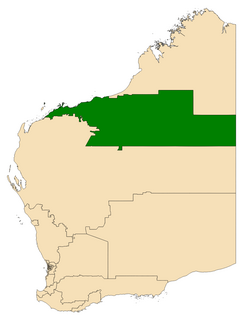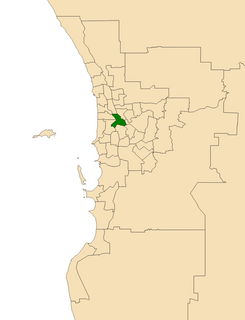| Swan Western Australia—Legislative Council | |
|---|---|
| State | Western Australia |
| Dates current | 1870–1890 |
| Namesake | Swan River |
Swan, officially called The Swan, was an electoral district of the Legislative Council of Western Australia from 1870 to 1890, during the period when the Legislative Council was the sole chamber of the Parliament of Western Australia.

The Western Australian Legislative Council is the upper house of the Parliament of Western Australia, a state of Australia. It is regarded as a house of review for legislation passed by the Legislative Assembly, the lower house. The two Houses of Parliament sit in Parliament House in the state capital, Perth.

The Parliament of Western Australia is the bicameral legislature of the Australian state of Western Australia, forming the legislative branch of the Government of Western Australia. The parliament consists of a lower house, the Legislative Assembly, an upper house, the Legislative Council and the Queen, represented by the Governor of Western Australia. The two Houses of Parliament sit in Parliament House in the state capital, Perth.
Swan was one of the original ten Legislative Council districts created by the Legislative Council Act 1870 (33 Vict, No. 13). The district's boundaries included large portions of what is now the western Wheatbelt, as well as areas that are now considered part of the Perth metropolitan area. This included the Swan Valley and the Perth Hills, with the district's southernmost point being Mount Dale. The district was bordered by the district of Toodyay to the north and east, the district of York to the east, and the district of Perth to the south. [1] One of the largest settlements in the district was Guildford, which had not yet been integrated into Perth.

The Wheatbelt is one of nine regions of Western Australia defined as administrative areas for the state's regional development, and a vernacular term for the area converted to agriculture during colonisation. It partially surrounds the Perth metropolitan area, extending north from Perth to the Mid West region, and east to the Goldfields-Esperance region. It is bordered to the south by the South West and Great Southern regions, and to the west by the Indian Ocean, the Perth metropolitan area, and the Peel region. Altogether, it has an area of 154,862 square kilometres (59,793 sq mi).

Perth is the capital and largest city of the Australian state of Western Australia. It is named after the city of Perth, Scotland and is the fourth-most populous city in Australia, with a population of 2.04 million living in Greater Perth. Perth is part of the South West Land Division of Western Australia, with the majority of the metropolitan area located on the Swan Coastal Plain, a narrow strip between the Indian Ocean and the Darling Scarp. The first areas settled were on the Swan River at Guildford, with the city's central business district and port (Fremantle) both later founded downriver.

The Swan Valley is a region in the upper reaches of the Swan River between Guildford and Bells Rapids, Western Australia. It is bordered to the east by the Darling Scarp. Both Ellenbrook and Jane Brook lie within the region and discharge into the Swan River. There are eight suburbs within the region: Baskerville, Belhus, Caversham, Henley Brook, Herne Hill, Middle Swan, Millendon and West Swan. It is part of the City of Swan local government area.
Nine men represented Swan in the Legislative Council between 1870 and 1890, the most of any Legislative Council district in that time. Walter Padbury served the longest, from 1872 to 1878, while William Locke Brockman, E. T. Hooley, and Samuel Hamersley each served for less than six months. Hector Rason, the district's eighth representative (from 1889 to 1890), went on to become Premier of Western Australia. [2]
Walter Padbury was an Australian pioneer and philanthropist.

William Locke Brockman was an early settler in Western Australia, who became a leading pastoralist and stock breeder, and a Member of the Western Australian Legislative Council.

Edward Timothy Hooley, usually known as E. T. Hooley or Tim Hooley, was an explorer in Western Australia, who in 1866 pioneered an overland stock route from Geraldton to the Ashburton River. He entered politics in later life, serving nearly three years as a Member of the Western Australian Legislative Council, then nearly six years in the Western Australian Legislative Assembly.


